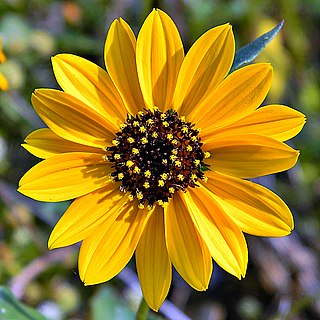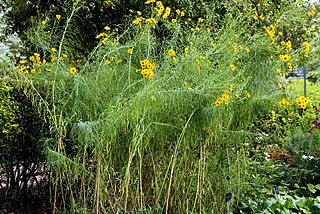
The common sunflower is a species of large annual forb of the genus Helianthus. It is commonly grown as a crop for its edible oily seeds. Apart from cooking oil production, it is also used as livestock forage, as bird food, in some industrial applications, and as an ornamental in domestic gardens. Wild H. annuus is a widely branched annual plant with many flower heads. The domestic sunflower, however, often possesses only a single large inflorescence atop an unbranched stem.

Helianthus is a genus comprising about 70 species of annual and perennial flowering plants in the daisy family Asteraceae commonly known as sunflowers. Except for three South American species, the species of Helianthus are native to North America and Central America. The best-known species is the common sunflower. This and other species, notably Jerusalem artichoke, are cultivated in temperate regions and some tropical regions, as food crops for humans, cattle, and poultry, and as ornamental plants. The species H. annuus typically grows during the summer and into early fall, with the peak growth season being mid-summer.

Helianthus bolanderi is a species of sunflower known by the common names Bolander's sunflower and serpentine sunflower. It is native to California and Oregon, where it grows mainly in mountainous areas, often in serpentine soils. It has been found from southwestern Oregon as well as in northern and central California as far south as Santa Cruz County, with reports of a few isolated populations in southern California.
Helianthus exilis is a species of sunflower known by the common name serpentine sunflower. It is endemic to northern California, where it grows mainly in mountainous areas, often in serpentine soils.

Helianthus californicus is a North American species of sunflower known by the common name California sunflower. It is native to California in the United States and Baja California in Mexico, where it grows in many types of habitats.

Helianthus cusickii is a species of sunflower known by the common names Cusick's sunflower and turniproot sunflower. It is native to the western United States from Washington, Oregon, Idaho, northern California, and northwestern Nevada.

Helianthus maximiliani is a North American species of sunflower known by the common name Maximilian sunflower.
Helianthus niveus is a species of sunflower known by the common names showy sunflower and snowy sunflower. It is native to northern Mexico and the Southwestern United States.

Leontodon saxatilis is a species of hawkbit known by the common names lesser hawkbit, rough hawkbit, and hairy hawkbit. It is native to Europe and North Africa but can be found in many other places across the globe as an introduced species and often a noxious weed. This is a dandelion-like herb growing patches of many erect, leafless stems from a basal rosette of leaves. The leaves are 2 to 15 centimeters long, 0.5 to 2.5 centimeters wide, entire or lobed, and green in color. Atop the stems are solitary flower heads which are ligulate, containing layered rings of ray florets with no disc florets. The florets are yellow with toothed tips. The fruit is a cylindrical achene with a pappus of scales. Fruits near the center of the flower head are rough, while those growing along the edges of the head are smooth.

Chlosyne lacinia, the bordered patch or sunflower patch, is a North and South American butterfly in the family Nymphalidae.

Helianthus petiolaris is a North American plant species in the family Asteraceae, commonly known as the prairie sunflower or lesser sunflower. Naturalist and botanist Thomas Nuttall was the first to describe the prairie sunflower in 1821. The word petiolaris in Latin means, “having a petiole”. The species originated in Western United States, but has since expanded east. The prairie sunflower is sometimes considered a weed.

Helianthus debilis is a species of sunflower known by the common names cucumberleaf sunflower, beach sunflower, weak sunflower, and East Coast dune sunflower. It is native to the United States, where it can be found along the Atlantic and Gulf Coasts. It is known elsewhere as an introduced species, such as South Africa, Australia, Taiwan, Slovakia, and Cuba.

Helianthus angustifolius is a species of sunflower known by the common name narrowleaf sunflower or swamp sunflower. It is native to the south-central and eastern United States, found in all the coastal states from Texas to Long Island, and inland as far as Missouri. It is typically found in the coastal plain habitat, particularly in wet areas.

Helianthus atrorubens is a North American species of sunflower known by the common name purpledisc sunflower. It is native to the southeastern United States. It is found in all the coastal states from Louisiana to Virginia, plus the inland states of Kentucky and Tennessee.
Helianthus floridanus is a species of sunflower known by the common name Florida sunflower. It is native to the southeastern United States, found in all the coastal states from Alabama to North Carolina, plus Louisiana.
Helianthus heterophyllus is a species of sunflower known by the common names variableleaf sunflower and wetland sunflower. It is native to the coastal plain of the southern United States from Texas to North Carolina.

Helianthus hirsutus is a North American species of sunflower known by the common name hairy sunflower. It is widespread across south-central Canada, the eastern and central United States, and northeastern Mexico. It ranges from Ontario south to Florida, Coahuila, and Nuevo León, and west as far as Minnesota, Nebraska, and Texas.

Helianthus mollis is a species of sunflower known by the common names ashy sunflower, hairy sunflower or downy sunflower. It is widespread across much of the United States and Canada, primarily the Great Lakes region from Ontario south to Texas and Alabama. Additional populations are found in the states of the Atlantic Coast from Maine to Georgia, but these appear to be introduced.

Helianthus salicifolius is a North American species of sunflower known by the common name willowleaf sunflower. It is native to the central United States, primarily in the Great Plains and Ozark Plateau. There are a few reports of scattered populations in the Northeast and Midwest parts of the country, but these appear to be escapes from cultivation.
Helianthus smithii is a rare North American species of sunflower known by the common name Smith's sunflower. It is native to the southeastern United States, in Tennessee, Alabama, and Georgia.
















